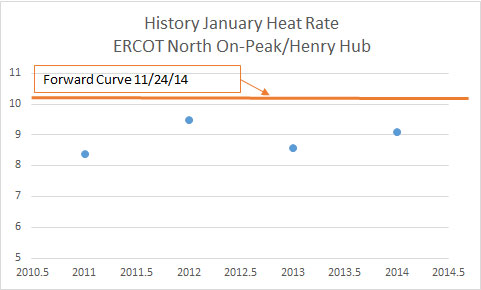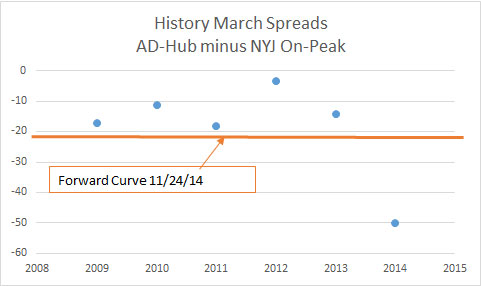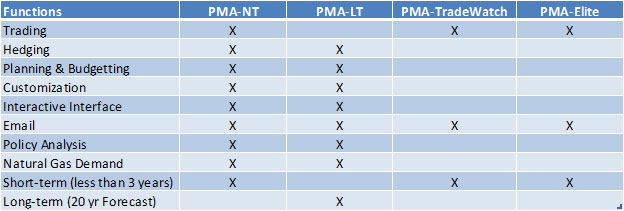Best of Market Insights 2014
To my readers, clients, and prospective clients,
I appreciate your feedback throughout 2014. The year 2014 will be remembered as the year of discovery for All Energy Consulting (AEC). An identity for AEC had to be discovered – better late than never. I know I had to work more on delivering my value proposition to you. I have spent so much time on developing products/services plus analyzing markets I lost sight of delivering this message. You will see an enlightened AEC moving into 2015. Our value proposition to my readers and prospects will be clear. I want to share the current thoughts on this in our Branding Positioning Statement:
“For those who need forecasted energy commodity prices, we are experienced market analysts who assist in the navigation of uncertain energy markets with a proven process and methodology, and a collaborative approach in consulting that yields clarity, transparency and empowers decision-making.”
You will see a change in 2015 with a clear direction to support the statement above.
Below are the best of market insights in 2014 rated based on web statistics – page views and downloads.
Your Very Grateful More Focused Energy Analyst – Happy New Years!,
David
614-356-0484
Best of Market Insights 2014:
– With the most page views (60K+) –Peak Energy – Are we there in the US? This is very surprising. Perhaps this is a result of peak oil conspirators or just an error in the web stats. The article uncovers the decoupling of the economy with load in several areas in the US.
– Excellent Returns Were Produced From PMA Summer Model Predictions This article highlights the performance of the generic PMA model for the summer. PMA correctly highlighted the hype from Polar Vortex bleed into the summer forwards. Also should read theBest Winter Trade which yielded 30%.
– Ready for March Gas Demand? Duke’s Merchant Coal Plant Value This article demonstrated PMA flexibility to not only help create risk-adjusted forward curves but also calculate natural gas demand and do specific power plant analysis. We also highlighted our agility with the ability to deliver results within 24 hours.
– US Refining Margins Outlook Sept. 2012 – Wow. An oldie had nearly 20K page views. This article highlighted that condensate production was going to change the markets and that US refining margins will be robust for years to come. Well it was an UNDERSTATEMENT – even though I was probably one of the few analyst mentioning the significance of condensate in 2012 the production of condensate blew past my old outlook. US Refining margins were and will be robust! See 2014 US Refining Outlook
– Most downloaded (403 downloads) – Summer of 2014 Analysis – I threw the kitchen sink and all into this analysis. If you took the time to really digest all of the information in the report you would have been prepared for what transpired in summer 2014.
The Clean Power Plan is Unconstitutional – Straight Up!
A flurry of comments has been made on the Clean Power Plan proposed by the EPA. Some of those comments came with actual study results behind them. The ERCOT study presents similar results based on my paper published in Fortnightly in the October issue. Texas will likely see a carbon price/cost somewhere between $20-$30/ton depending on the effectiveness in the building blocks described in the plan. I do try to make it clear in my paper, the biggest issue is not the cost, but how that cost is distributed among states.
The one comment making the headlines, which personally resonates with the paper I wrote, is by Harvard law professor Laurence Tribe – The Clean Power Plan Is Unconstitutional. In essence, I discuss this constitutional concern, but arising from the state’s economic pain. In my paper, I demonstrate the disproportional economic impact among the states and I actually run a sophisticated power model to do the mathematical calculations of the individual state impacts. Mr. Tribe paper is more eloquently focused on the constitutional merit by saying “… such federal commandeering of state governments defeats political accountability and violates principles of federalism that are basic to our constitutional order.”
The significant rebuttal to Mr. Tribe is his monetary gain from Peabody Energy, the largest private-sector coal company. I will not present arguments for Mr. Tribe’s potential bias or honor, but I will note my work on the Clean Power Plan was done with ZERO, NONE, NO monetary gain – to the dismay of my family finances. No one commissioned or paid or has paid for my work done on Clean Power Plan. I took time out from my schedule which was focused on launching my new product/service Power Market Analysis (PMA) to produce the paper presented in Fortnightly. The driver was pure intellectual curiosity and the desire for the truth – per my Alma Mata saying “The Truth Shall Set You Free” Hook’em.
I stand with Mr. Tribe in saying the current Clean Power Plan violates the principles of federalism that are basic to our constitutional order. This is not a debate on the cost or the benefits though there is much to discuss there. I believe the Clean Power Plan sets the stage for changing the political landscape towards a federalism world not supported by the original constitution. For not being a constitutional scholar as such as Mr Tribe, I was hesitant to directly discuss the constitution in my paper. I had to prove the issue through cost pains from various states, which would arise to the constitutional concerns. With such a scholar of the constitution now coming out on the legislation, I would have written my paper with more discussion on the constitutional concerns versus hinting at the issue.
My curiosity continues to get the best of me versus focusing my efforts to grow my family nest egg. I have not written much given I am spending so much time reading and analyzing the “Most expensive regulation ever” claimed by the National Association of Manufacturers. On November 25, 2014 EPA proposed strengthening the National Ambient Air Quality Standards (NAAQS). The proposal is an astounding 626 pages! We need verbage control! The original Clean Air Act in 1970 is 36 pages long. There is a ton of repetition and just plain verbose in the proposal. I wonder if this is a strategy so people no longer read the entire bill. I am half way through as I stop to learn and verify the comments made. My recent curiosity drove me to look at actual improvements in ozone over the last decade. We have come a long way in reducing ozone levels. The New England area has seen 90 days of exceeding the standards in 1983 to under 10 days over the last few years. They should be presenting the efficacy of this effort, but they spend more time on laboratory experiments deducing ozone MAY/CAN/LIKELY be harmful. More to come….
From my family to yours, we wish you a Happy, Healthy, and Safe Holiday season. Please do consider All Energy Consulting for your energy consulting needs.
Your Ever Curious Energy Analyst,
David
David K. Bellman
All Energy Consulting LLC- “Independent analysis and opinions without a bias.”
614-356-0484
[email protected]
@AECDKB
blog: https://allenergyconsulting.com/blog/category/market-insights/
Capacity Market – Lipstick on a Pig – Part 2
“The desire for safety stands against every great and noble enterprise” Tacitus
If you do not already know about the capacity market please read Part 1 – History of Capacity Market.
The Proposed Capacity Market
Due to the polar vortex of 2013/2014, several hours observed extremely high outages leaving a potential reliability concern. The deduction from PJM for the cause of this issue was that the compensation and non-performance penalty was not sufficient to ensure system reliability. Therefore, they have created a modification of the RPM Model. The new rules will add significant constraints to participation in the capacity auction plus adds more penalties. The bulk of the capacity value will come from Capacity Performance (CP) resources. These resources need to provide sustained, predictable operation 16 continuous hours per day for three consecutive days – during both summer and winter peak load and extreme weather conditions. CP resources must also have a startup time of less than 24 hours under normal conditions, and 14 hours under hot or cold weather alert periods. This essentially eliminates any consumer behavioral options including many popular Demand Response programs such as A/C cycling since this will not likely occur in the winter.
In general, all the utilities are supporting this move other than a little maneuvering to lower the penalty cost. This new layer of RPM will essentially give existing generation a huge boost in earnings – hence the upgrades of many utilities. This certainly smells and feels like a knee jerk reaction by PJM. This move appeases the utility and will very likely avoid the societal backlash of having to deal with brownouts.
The consumer is not seeing the price signal nor the real cost of power by overlaying it with such a high level of capacity value with limited participation from outside technology. The utilities and PJM are certainly making sure to take advantage of the situation by pushing this through.
My first concern is the extrapolation from the outages being related to the capacity payments. It is true that RPM is designed for the peak- which is summer not winter. However, the balance issue cannot be attributed to the RPM construct. In order to understand the PJM issue that occurred in January 2014, you have to have an appreciation of what occurred in the past two years.
For the past two years, PJM observed relatively mild winters. In addition, in each of those two years, natural gas price eroded the energy share of coal generation. For most of 2013, you had the natural gas price forward prices below $4/mmbtu throughout the winter of 2013/2014. In addition, 2012 and 2013 were not good years for any generators in particular coal generators due to the low power prices. It would be very reasonable to expect a Sr. Commercial Operations Manager to question the budget for winterizing coal units to run in the winter time leading into the 2013/2014 winter. Based on two years of history, one could see the coal plants did not run significantly, yet required a fixed cost that was not being recovered. In my estimate, many took the gamble to cut the FOM allocation for winterizing the coal units. The data potentially shows this to be the case. On January 7th 2014, coal units represented the largest component of the outages at 34% with gas following at 23%. This is not a case of capacity rules having to be modified. The reason I state this is because it is clearly a free market lesson on not being penny wise and pound foolish. AEP coal units fared well in the outage and they ended up with record profits almost doubling 2013 1Q profits – $560 million in profits. I can promise one thing this year. The Sr. Commercial Operations Manager is not questioning the budget request from the coal plants to winterize the facility. He can get fired for making the mistake twice, but he won’t get fired for spending more fixed cost on a unit that may not run this winter.
In terms of the gas unit outages, this can be partially attributed to the past. Typically, gas units did not run very much particularly in the western PA and Ohio regions. Firm gas capacity can be purchased by the utility. Because the units historically didn’t run much, fixed cost would translate to much higher gas bidding cost which, in turn, would lead to even less running of the gas plants. When I was at AEP, I was promoting buying firm capacity and selling the capacity to various counter parties during low usage time periods to mitigate some of the cost. However, as noted before, change is very hard in a utility and there is more risk than reward to change behavior. Even though many utilities generation are de-regulated, it still takes time to change the culture. It will change. But, one shouldn’t expect it to change within only a few years. However now that gas prices have been competitive for multiple years, the utilities should have learned the value of buying firm capacity. I am confident firm gas transport is being purchased now and will grow in the future. Sometimes, the market needs time to learn from first-hand experience vs. people advising them.
The very party who stands to benefit from the de-regulation and the free market model is not allowing the model to be free. Free markets need to learn from the market not to be coddled by additional monetary mechanism, or else you get a system that would extensively be more costly than regulation. This new capacity construct eliminates innovation. It will produce a safe environment for reliability – but so did regulation. If we continue down this path of coddling the system and not allowing the consumer and participants to see their consequences of their actions, we will be no better than regulation and likely potentially worse. PJM will be creating a system of limited downside risk with all the upside rewards. Case in point, AEP Ohio historical earnings for 2014 Q1 would have been shared back to the rate payers in Ohio. Because AEP Ohio generation spun off in 2013, it was all kept in house – Good Timing for AEP!
If we want to keep it safe then let us go back to regulation or let the market learn its lesson and remove the knee-jerk safe call so we can create something great and noble.
Your Open to New Ideas and Thoughts Energy Analyst,
David
David K. Bellman
All Energy Consulting LLC- “Independent analysis and opinions without a bias.”
614-356-0484
[email protected]
@AECDKB
blog: https://allenergyconsulting.com/blog/category/market-insights/
Part 1: Capacity Market – Lipstick on a Pig
“The desire for safety stands against every great and noble enterprise” Tacitus
Please ponder the above quote from a Roman philosopher. This quote applies to many things beyond this discussion of capacity markets in the power sector.
PJM is making a drastic change in its capacity model. This is a two part article with the first part covering the creation of the capacity market. I believe if you understand how you got to where you are now, you will be better equipped to reflect on the future. Part 2 will go over the issues in the new PJM proposed capacity market.
History of Capacity Markets
Unfortunately, an analysis on the capacity markets cannot be examined without a discussion of regulation vs. de-regulation. To many, this is akin to discussing politics, race, and/or religion. I will attempt to stick with the facts and avoid absolutes.
In a regulated world, there is no need for a capacity market as investments are made once the utility shows to the utility commission the investment is prudent to meet a certain loss of load probability requirement. In a perfect world, the commission, interveners (industrial lobbyist, consumer protections groups), and the utility produce some reasonable acceptance to the need of generation capacity and then, and only then, does generation get built. In return for this consensus opinion, the utility is protected from a loss if the generation is not needed in the future. At the same time, the utility is capped in its earning potential.
However, this regulated system does come with some cost as previously discussed in my Regulation vs. De-Regulation article. A regulated system does not bode well for adoption of new methods and technology. The system is focused on maintaining. Overtime cost can rise without proper oversight from the commission. As I noted in a previous article, this is likely inevitable given the poor levels of compensation in the commission. In my latest research, the Ohio public utility commission earns between $75-$160K per governor approval. This is a full time job as commissioners are not only regulating electric utilities but also natural gas, telephone, water, railroad, and motor carriers.
Within the electric sector, they are dealing with the executives making multi-million dollar salaries each year. Then the senior management team earns around $500K with directors making $130-300K. You have analysts coming out of college in the utility, potentially, making more than the commissioners and their staff. With this design, it is no wonder the effectiveness of regulation would wane. It is certainly reasonable to expect commissioners and staff to have the potential desire to work at the utility in order to support their families. This very fact could make it hard for some to really clamp down on their potential employer. Please note none of my statements are absolutes nor are they confirmed in anyway with current commissioners or staff. I use my practical insights on human behavior to potentially deduce these outcomes along with past history. There has been confirmed revolving door in the electric utility space as in the Duke Energy Corp case where the chief legal counsel for the states utility regulatory agency joined Duke Energy Corp after presiding on two cases favorable to Duke. I strongly suspect, if he ruled unfavorably in the cases, he might not have had the job.
The history of poor regulatory decisions led many to investigate the de-regulation option vs. fixing the regulatory process through increase budget to source and retain skilled and experience commission and staff. Ideally, competition will drive the inefficiencies out of the market that the regulatory body could not. Theoretically it made sense given poor decisions were not being punitive as in a free market and the drive for innovation was not there as there was no earnings potential beyond a set return. Both of these points still could have been somewhat managed by the regulatory agencies. Another bonus of de-regulation many touted was allowing greater transparency and market discovery which would potentially allow new companies to innovate and capture the market thereby reducing society cost. De-regulation would drive the inefficiencies out of the market and the innovative nature of competition will drive the cost down further. It all sounds so good on paper.
Markets became de-regulated with California leading the way. We all know what happened there. The first market inefficiency they attacked wasn’t the inefficient operation of the utility but the inefficiencies of the market model – Enron Strategy. To me, this highlights that the inefficiency of the utility really isn’t that large compared to the inefficient market designs. If you think this was resolved due to the experience in California – think again. In 2010 JP Morgan hired John Howard Bartholomew. He wasn’t hired to progress the electric industry nor drive out inefficiencies in the utility but to find the inefficiencies in the market design. Once again they quickly identified inefficiencies and targeted those arbitrages to the benefit of themselves. A regulated entity would have not done that given the lack of incentive. However, these free market players realize there is more money in market manipulation than the boring optimization of power plant supply chain. In addition, the risk from getting “caught” still produces a decent return on investment after accounting for the penalties.
As an outcome, many deregulated markets kept a price cap to “protect” the consumer. PJM price cap is at $1000/MWh. ERCOT is having to raise their price cap as they stayed on the moral high ground on de-regulation and continued without a capacity market. The one thing ERCOT is doing is raising the market price cap from $2,500/MWH (2011) to $9,000/MWH (2015) in order to incentivize generation build. To prevent a market brownout or blackout, demand must be met even in the one instantaneous moment of ultra-high demand. Typically, power planners will build peakers to run for those given moments. However, in a free market system, they need to have enough revenue during those small times to make up for the cost of building the unit. Therefore, if your peaker cost you 85 million dollars for 85 MW and you only ran 40 hours in the year in order to have a payback in 3 years without any discounting you would need prices to average over $8300/MWh PLUS variable cost during those 40 hours. Variable cost can be over $100+/MWh given rise in fuel prices in extreme times. ERCOT is running the grand experiment to drive new technology and new methods through price incentives – the quintessential mechanism of a free market. It is just math. A market with regulation typically gets a return on investment between 8-12%. If the market is free to compete, the risk is increased. Therefore, the reward needs to increase above the regulated return requirements. The returns will likely need to grow to over 15+% rate of return. The means to this return, I contend, is too great for society. I do agree the potential for a more efficient market is very possible with an open market, but society and potentially the oversight body is not willing to take the means needed to achieve the ends of a more efficient market.
Other Regional Transmission Organizations (RTO) realized the incentive to build generation with power prices alone did not meet their historical comforts of market reserve margins and consumer pricing. They became concerned about the customer backlash to the de-regulated market, if they could not deliver the same comforts of a regulated market. The capacity market was born to hide this issue while still touting the free market solution as the answer to society’s needs. PJM came out with Reliability Pricing Model (RPM). RPM creates another layer of payment beyond the price of power. In theory, it is the value of having capacity available to serve load. Payment is based on the size of your capacity offer. The initial model was opened to all sorts of capacity options from coal plants to non-generating capacity from demand response aggregators. This model still offered some innovation by just targeting the peak demand and not putting so many strings to the participation in the auction. At this point I still believed there was a possibility to obtain the promise savings of de-regulation.
However, the latest proposal to modify RPM by PJM goes against the “free” de-regulated concepts of free market competition. The proposed RPM is likely losing all the value of being de-regulated compared to regulation. Stay tune for your early Sunday release as we detail the latest PJM PRM proposal in Part 2 Capacity Market – Lipstick on a Pig.
Your Willing to Step Out of the Box Energy Analyst,
David
David K. Bellman
All Energy Consulting LLC- “Independent analysis and opinions without a bias.”
614-356-0484
[email protected]
@AECDKB
blog: https://allenergyconsulting.com/blog/category/market-insights/
Another 30% return in Month Time? – Next Trade De Jour
It will be hard to beat my BEST winter trade call for buying the Dec. 2014 AD-HUB minus NYJ spread – As of 11/24/14 close, the spread moved to -$31/MWh vs. when we wrote about it at -$44/MWh – up 30% since October 9th 2014. I hope all of you took my advice when you read about it.
Likely my last and final timely free call to you (in this case the release was delayed only a few days -some received an early release of the analysis ahead of time) will be to sell the January Ercot North On-Peak Heat Rate (ERCOT North On-Peak / Henry Hub) and to once again take a look at buying the AD-HUB minus NYJ Spread this time in March 2015. As previously discussed, the process to identify these trades was to use the built in screeners from PMA-NT default runs. Then, a complete analysis was applied to stress test these trades, both from a future and historical perspective, as described in my previous article.
The ERCOT North Heat Rate sell is based on over 50 simulations plus a historical perspective. This is not going to be a huge money maker but the risk of loss is minimal. The current forward curve is showing a 10.11 mmbtu/ MW heat rate. In the last 4 years, the highest heat rate achieved was 9.54 in January 2012 and the lowest was 8.4 January 2011. Based on over 50+ simulations, the average heat rate was 9 with only 1 simulation greater than 10 at 10.5. I feel very comfortable with this trade.
The AD-Hub minus NYJ On-peak spread has treated us very well this winter. Examining the March 2015 spread, we see the same opportunities. Currently, the spread is trading at -$23/MWh. Unlike our past call, there is more risk in this trade. There is 1 simulation – the weather profile of 2013-2014 – which produces a -$52/MWh trade. This compares with the historical actuals of 2014 March of -$51/MWh (Nice Calibration!). Outside last year, from 2009-2013, the March spread has averaged -$13/MWh. The 50+ simulations produced an average of -$16/MWh (which includes the one simulation that was more negative than $25/MWh). This is a great trade if you feel comfortable with the weather risk. In our slew of simulations we did run the weather for the past 12 years with only 1 year indicating a loss for this trade.
I will release a new publication product – PMA-TradeWatch. PMA-TradeWatch will screen out trades based on the default setup of PMA with a layer of historical screening. These trades will represent the first layer (identification) of trades to look into. A file will be sent daily to subscribers. As I noted in my process in finding the BEST winter trade, it takes more work than the initial screen to really prove this to be a trade to place your money on. PMA-TradeWatch is a report to indicate to you potential trades. With this list it will narrow the amount of investigation. Ultimately I would recommend running more simulations and applying more historical analysis. Following this process will lead to successful trades similar to my best winter trade. We could facilitate the process for additional simulation and analysis for an additional fee. However, at some point, it would be more cost effective to do PMA-NT.
We may release another product PMA-Elite which goes above and beyond PMA-TradeWatch and goes through the process and does the work to give these winning trades. PMA-TradeWatch is an ideal augmentation for those who already are staffed with a full team of analyst. They can shoot holes and discover the winning trades from the list supplied by PMA-TradeWatch. PMA-Elite is designed for traders needing the complete analytical solution to finding money making power trades. Both PMA-TradeWatch and PMA-Elite are focused on trading. Our other products are designed for greater breadth of usage – see below table for summary.
We hope that all our articles have proven the success and efficacy of our Power Market Analysis platform (Summer Trading, Summer Hedging, Winter Trading). Please do consider All Energy Consulting for your analytical needs in the power spectrum. All fuels ultimately lead to power. Building up the energy foundation from power makes sure all things are tied together.
I hope you had a wonderful Thanksgiving. Thank you so much for all of your support.
Your VERY Thankful Need to Exercise Energy Consultant,
David
David K. Bellman
All Energy Consulting LLC- “Independent analysis and opinions without a bias.”
614-356-0484
[email protected]
@AECDKB
blog: https://allenergyconsulting.com/blog/category/market-insights/
Ethane Favored Status – another convergence to power
I have had many responses to my previous article Splitting the Profit – Condensate Splitter Under Pressure. Let me clarify some of my points and highlight some valid feedback.
US ethylene production is mainly from ethane, whereas the rest of the world is Naphtha. However, the point I was trying to extend is the rest of the world may very well also move to more ethane, as I believe ethane exports are viable via ships that carry ethylene – see below. This puts more pressure on Naphtha pricing as the rest of the world can eventually shift to ethane if Naphtha pricing is not in balance with ethane. In addition, given the expansion of ethane crackers in the US, this may very well put pressure on ethylene cracking margins which then translates to feedstock such as Naphtha.
In summary, my main concern being expressed in the original article are those investing in condensate splitters, in hopes of mitigating the condensate discount, may just be shifting their concerns to Naphtha discounts. As noted previously I believe there is room for condensate refineries. I have been working on one that just needs funding. As with many things, in order to make money you need money. This is a refurbishment for an existing condensate refinery with a cost range between $400-600 million. I can supply more information just send me an email [email protected].
I certainly was not trying to completely solve the ethane issues in the previous article. There is no doubt ethane problems are real and will be very challenging, particularly the next few years as many projects are still in permitting phase. Based on the available information, I believe exporting ethane is the way to balance the market in the meantime. As noted above, one could use ethylene carriers to transport ethane. Ethane can potentially be the “bridge” fuel for locations requiring power, but without the required scale of LNG. There are several engine manufacturers working to be able to use higher and higher content of ethane. Ethane use for power generation can easily be converted to LNG when the required scale is reached. In the meantime, regions burning oil (many outside US) can look to this economical and viable alternative to oil. With ethane flexibility to be used in petrochemical and power generation, ethane may actually end up being a favorite child from a step child as I alluded to in the first article.
All fuels ultimately lead to power. Building up the energy foundation from power makes sure all things are tied together. Many consulting companies are driven from the Oil & Gas side of the analysis as more revenue comes from those industries, but at All Energy Consulting we are driven through intellectual integrity. We report to no shareholders and have no targeted mandates.
We wish you a Happy and Safe Thanksgiving. Thank you so much for all of your support.
Your VERY Thankful Full Spectrum Energy Consultant,
David
David K. Bellman
All Energy Consulting LLC- “Independent analysis and opinions without a bias.”
614-356-0484
[email protected]
@AECDKB
blog: https://allenergyconsulting.com/blog/category/market-insights/
Sign Up to AEC Free Energy Market Insights Newsletter
“Pull a thread here and you’ll find it’s attached to the rest of the world.”
Nadeem Aslam, The Wasted Vigil










